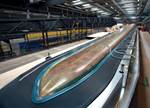Wind foam sources: PET, SAN & PVC
That polyethylene terephthalate (PET) foam is the core material of the future appears to be an open secret within the composites industry.
That polyethylene terephthalate (PET) foam is the core material of the future appears to be an open secret within the composites industry. Almost all of the major core material suppliers offer a wind-specific PET at some level. PET is not always identified as the material type, but manufacturers’ product descriptions that include terms like “recyclable” and “thermoplastic” are important clues. PET is the most abundant polymer in the world and is the primary material for all water and beverage bottles, but expert observers say it is not yet ready to supplant other core products. Until its performance levels are improved, styrene acrylonitrile (SAN) and polyvinyl chloride (PVC) foams will remain the standard. Sources for all three types follow:
3A Composites’ (formerly Alcan Composites, Northvale, N.J. and Sins, Switzerland) introduced the foaming of PET as a core material and holds patents on its manufacture and production. Their primary wind blade variation is AIREX T92 PET foam, which is compatible with vacuum infusion, adhesive bonding, prepreg, RTM, compression molding and thermoforming.
Armacell LLC (Mebane, N.C.) offers its own PET core, called ArmaFORM PET and ArmaFORM PET green, the latter tag applied to emphasize the material’s recyclability and the fact that it is manufactured using recycled PET bottles. DIAB Sales Inc. (DeSoto, Texas) offers PET under the name Divinycell P, which has densities of 3.9 to 9.4 lb/ft3 and is said to be useful in closed molding and resin transfer molding (RTM). Gurit (Isle of Wight, U.K.) offers G-PET, one of a suite of products Gurit has developed for wind blade manufacturing, including resin and tooling, together with design and kitting services. Nida-Core (Port St. Lucie, Fla.) produces Nida Foam P.E.T. According to the company, the material has 95 percent formation of closed cells and features thermoformability as well as chemical and heat resistance.
Gurit’s SAN foam core for wind is Corecell T-Foam and K-Foam. Both are marketed as a PVC or balsa replacement and do not outgas. T-Foam can withstand processing temperatures up to 120°C/248°F; K-Foam can withstand temperatures up to 140°C/284°F. 3A Composites’ PVC foam core is branded Airex C70 and C71. They are designed for use in blades and feature uniform cell size and low resin absorption. DIAB’s PVCs are Divinycell H and HP. Divinycell H is designed for infusion systems, while HP is designed for medium-temperature prepreg applications.
Related Content
-
Combining multifunctional thermoplastic composites, additive manufacturing for next-gen airframe structures
The DOMMINIO project combines AFP with 3D printed gyroid cores, embedded SHM sensors and smart materials for induction-driven disassembly of parts at end of life.
-
Jeep all-composite roof receivers achieve steel performance at low mass
Ultrashort carbon fiber/PPA replaces steel on rooftop brackets to hold Jeep soft tops, hardtops.
-
Plant tour: Albany Engineered Composites, Rochester, N.H., U.S.
Efficient, high-quality, well-controlled composites manufacturing at volume is the mantra for this 3D weaving specialist.













